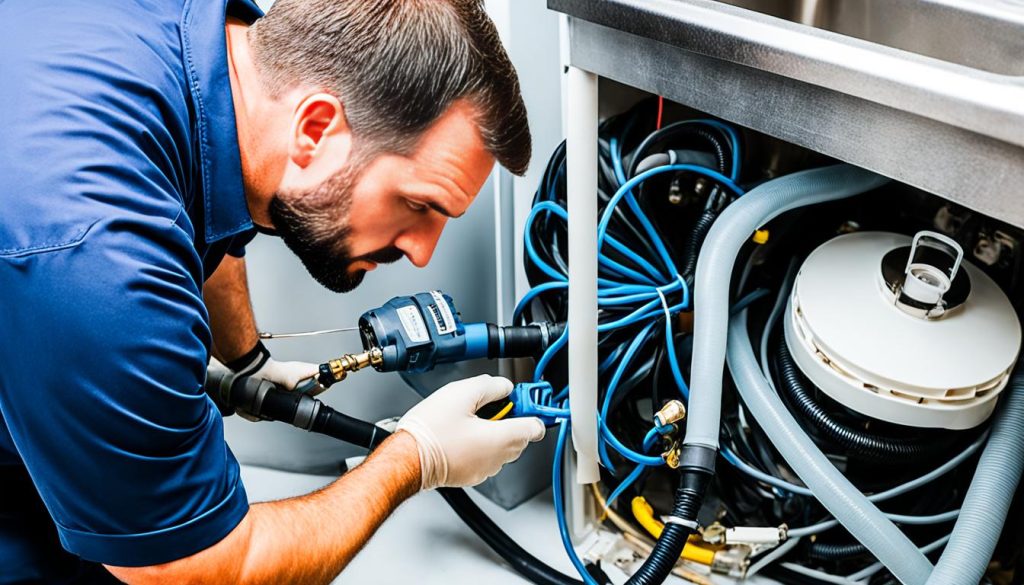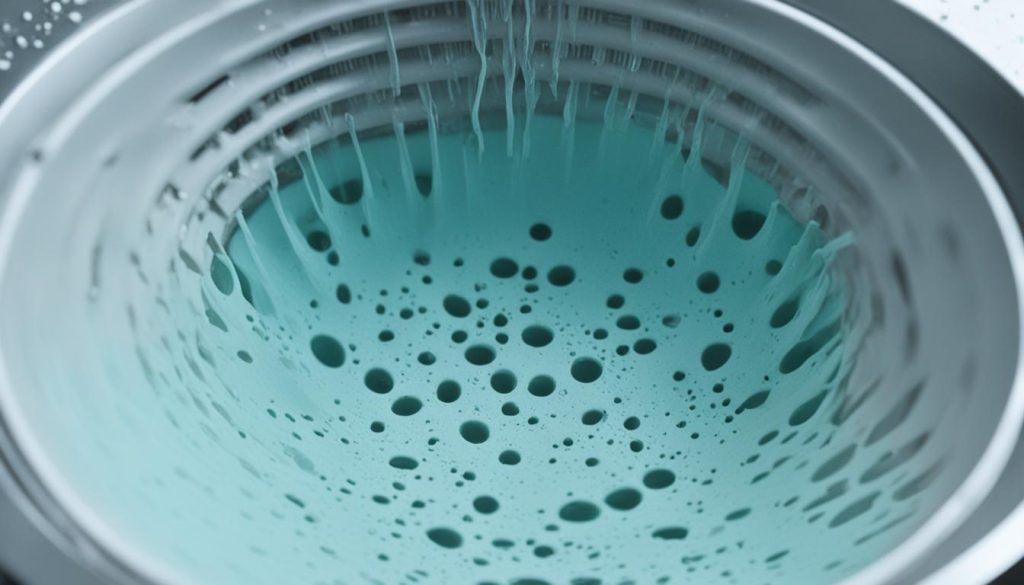Solve It Now: Dishwasher Not Draining Fix
Did you know that a staggering 30% of kitchen appliance repair calls in Canada are related to dishwashers not draining properly? If you’ve ever opened your dishwasher and found standing water at the bottom, you’re not alone. It can be frustrating and inconvenient, but the good news is that there are DIY solutions available to fix this common issue.
Key Takeaways:
- Troubleshoot common dishwasher drainage problems before calling a professional.
- Inspect the drain connection, check for kinks, and clean the air gap or drain basket.
- Unclog the dishwasher drain by cleaning the filter and using baking soda and vinegar.
- Prevent future clogs by removing food debris and regularly cleaning the dishwasher filter.
- Consider upgrading to a new dishwasher if the problem persists.
Troubleshooting Common Dishwasher Drainage Problems
If you’re experiencing a dishwasher drainage issue, it’s essential to troubleshoot the problem before seeking professional help. By following a few simple steps, you can often fix the issue yourself and save time and money. In this section, I will guide you through the common causes of dishwasher drainage problems and provide DIY solutions.
Determine the type of drain connection
One of the first steps in troubleshooting a dishwasher not draining is identifying the type of drain connection you have. This could be a high loop to a disposal or drain, or an air gap to a disposal or drain. Knowing the type of connection will help you diagnose the problem more effectively.
If you have a high loop, check for any kinks in the drain hose that might be causing a blockage. Straighten out any kinks and ensure the hose is properly connected. For air gaps, inspect the air gap and drain basket for any clogs. Clearing out any debris can often resolve drainage issues.
Run the garbage disposal and clean the air gap
In some cases, the dishwasher drainage problem may be related to a clogged garbage disposal or air gap. Running the garbage disposal can help clear any blockages in the drain system. Additionally, cleaning the air gap by removing the cap and clearing any debris can improve drainage performance.
Use the correct dishwasher detergent
Believe it or not, using the wrong dishwasher detergent can contribute to drainage problems. Improper detergent can create excessive suds that hinder the draining process. Ensure you’re using the appropriate dishwasher detergent for your machine and follow the manufacturer’s guidelines.
If the DIY troubleshooting steps above don’t solve the dishwasher drainage issue, it may be necessary to call a professional dishwasher repair service. They have the expertise to identify and fix more complex problems that require specialized knowledge and tools.
Continue reading to learn how to unclog a dishwasher drain and prevent future clogs.
Unclogging the Dishwasher Drain
If you have determined that your dishwasher drain is clogged, there are a few steps you can take to unclog it.
Start by removing the dishwasher filter and cleaning it to remove any trapped debris. This is a common cause of clogged drains and a simple fix that you can do on your own.
If the filter is not the cause of the clog, inspect the drain valve and check if it is stuck or burned out. A malfunctioning drain valve can prevent proper drainage and may need to be replaced.
You can also try clearing the drain with a mixture of baking soda and vinegar. Pour half a cup of baking soda followed by a cup of vinegar down the drain. Let it sit for fifteen minutes, then flush the drain with hot water to see if the clog has been cleared.
If these DIY methods do not work, it may be necessary to replace the drain hose or seek the assistance of a professional. A damaged or blocked drain hose can also cause dishwasher drainage problems.
Unclogging the Dishwasher Drain – Step by Step
- Remove the dishwasher filter and clean it to remove any trapped debris.
- Inspect the drain valve and check for any issues like being stuck or burned out.
- Try clearing the drain with a mixture of baking soda and vinegar.
- If the clog persists, consider replacing the drain hose or contacting a professional for assistance.
| Problem | Solution |
|---|---|
| Dishwasher filter clogged with debris | Remove and clean the filter |
| Malfunctioning drain valve | Inspect and replace if necessary |
| Clogged drain | Try using a mixture of baking soda and vinegar |
| Blocked or damaged drain hose | Consider replacing the drain hose or seek professional help |
Preventing Dishwasher Clogs
To prevent future dishwasher clogs, there are several proactive steps you can take to keep your dishwasher running smoothly. By following these simple guidelines, you can avoid the hassle of a clogged dishwasher and ensure your kitchen appliances remain in top condition.
1. Remove Food Debris
Before loading your dishes into the dishwasher, make sure to remove any food debris. Rinse off plates, utensils, and cookware to prevent these particles from clogging the drain system. Taking a few seconds to scrape off excess food can save you from future drainage issues.
2. Clean the Dishwasher Filter
The dishwasher filter plays a crucial role in preventing clogs by trapping large food particles and debris. Regularly cleaning the filter, which is typically located at the bottom of the dishwasher, will ensure that it functions optimally. Remove the filter, rinse it under running water, and scrub away any residue. Reinsert the filter into its designated slot and rest easy knowing that your dishwasher is protected from potential clogs.
3. Run the Dishwasher Frequently
Running your dishwasher on a regular basis can help prevent clogs by keeping the drain system clear. Although it may seem counterintuitive, running an empty dishwasher with dishwasher detergent can flush out any accumulated debris and keep the drain functioning smoothly. Aim to run the dishwasher at least once a week to maintain its optimal performance.
4. Use Hot Water
When running your dishwasher, opt for hot water cycles whenever possible. Hot water helps dissolve grease and efficiently removes food residue, reducing the risk of clogs in the drain system. Additionally, hot water can help mitigate any potential buildup over time, keeping your dishwasher running at its best.
By following these preventative measures, you can significantly reduce the likelihood of dishwasher clogs and avoid the need for professional dishwasher repair. However, if you continue to experience drainage issues despite taking these steps, it may be beneficial to schedule regular professional maintenance for your dishwasher to ensure its longevity and efficiency.
5. Summary Table
| Prevention Steps | Benefits |
|---|---|
| Remove Food Debris | Prevents drain clogs caused by leftover food particles |
| Clean the Dishwasher Filter | Ensures optimal performance and prevents clogs |
| Run the Dishwasher Frequently | Flushes out debris and maintains a clear drain system |
| Use Hot Water | Dissolves grease and removes food residue effectively |
Upgrading Your Dishwasher
If you find that your dishwasher is frequently not draining despite troubleshooting and maintenance efforts, it may be time to consider upgrading to a new dishwasher. Upgrading to a newer model can provide improved drainage performance and additional features that can make your dishwashing experience more efficient and convenient. Consult with a professional to determine the best dishwasher option for your needs.
Are you tired of dealing with a dishwasher that won’t drain? Upgrading to a new dishwasher could be the solution to your problem. Newer models offer advanced drainage systems and innovative features that can prevent drainage issues and ensure your dishes come out spotless every time.
By investing in a professional dishwasher repair or replacement, you can enjoy the following benefits:
- Improved Drainage Performance: New dishwashers are designed with powerful motors and advanced drain systems that can effectively remove water from the dishwasher, preventing it from pooling at the bottom.
- Enhanced Features: Upgrading to a new dishwasher can provide you with additional features such as adjustable racks, specialized wash cycles, and advanced drying options, making your dishwashing experience more convenient and efficient.
- Energy Efficiency: Newer dishwashers are designed to be energy-efficient, helping you save on your electricity bills while minimizing your environmental impact.
- Extended Warranty: When you purchase a new dishwasher, it usually comes with a warranty that covers any repairs or replacements needed within a specific period, giving you peace of mind.
So, if you’re constantly struggling with a dishwasher that won’t drain, it’s time to consider upgrading. Consult with a professional dishwasher repair service to explore your options and choose a dishwasher that meets your needs and preferences. With a new dishwasher, you can say goodbye to drainage issues and enjoy hassle-free dishwashing for years to come.
Conclusion
When faced with a dishwasher not draining, it is important to first troubleshoot and attempt to fix the issue yourself. By following the steps outlined in this guide, you can often resolve common drainage problems without the need for professional assistance.
Start by checking the type of drain connection you have and inspecting for any kinks or clogs. Running the garbage disposal or cleaning the air gap can also help. If the drain is clogged, try removing the dishwasher filter and using baking soda and vinegar to clear it.
However, if you are unable to fix the issue or the problem persists, it may be necessary to seek professional dishwasher repair services. A trained technician can accurately diagnose and address the underlying cause of the drainage problem, ensuring the proper functioning of your kitchen appliance.
Remember, taking proactive steps to prevent future clogs such as removing food debris from dishes, regularly cleaning the dishwasher filter, and scheduling professional maintenance can help keep your dishwasher running smoothly in the long run. If all else fails, upgrading to a newer model may be a viable solution to improve drainage performance and enhance your overall dishwashing experience.
- Investing Wisely: How Windows & Doors in Boost Property Value and Financial Health - April 24, 2025
- The Financial Impact of Personal Injuries: Why Legal Help Matters for Business Owners - April 16, 2025
- The Hidden Financial Costs of Domestic Assault: What Business Owners Need to Know - April 16, 2025














